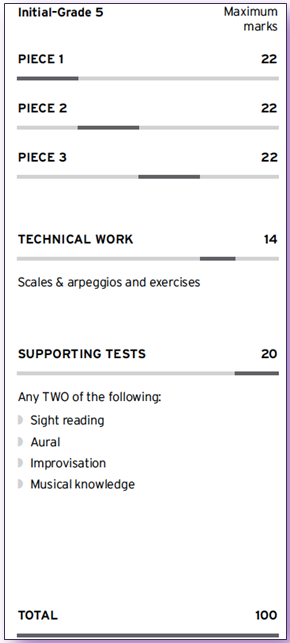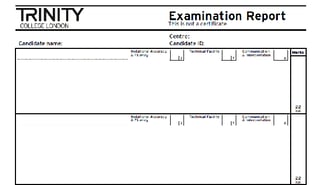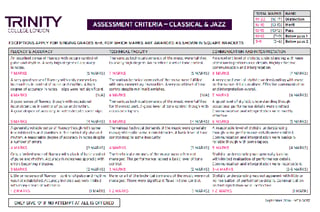
From Pass to Distinction: How examiners mark your exam
BY: Guest Writer
11 September 2024
It’s your exam day. It’s the day you’re either going to take your face to face exam, or record your digital one. This is it. After weeks of practice and preparation you are going to put your skills to the test.
Your face-to-face examiner is poised, pen in hand, ready to listen to your first piece or song, and if you’re recording a digital exam, you’re poised to begin. Deep breath...and before you know it, you are all done!
So how did you do? Did you play what the examiner needed to hear? Did you earn those extra few marks that could mean the difference between a Merit and a Distinction?
Having a good understanding of what the examiner will be assessing in your graded music exam helps focus your practice and sets you up for a great performance on exam or recording day.
Let us break down for you how your Trinity graded music exam is structured, what the examiner will be looking for during your performance and how the marks are calculated.
On your marks…

This summary shows you a breakdown of how the marks are distributed across the various elements of a Trinity face-to-face graded music exam.
You can see that these are slightly different for digital exams, where we have the Overall Performance Criteria instead of the Supporting Tests in the technical work pathway. And for the Repertoire-only pathway, the overall marks for each piece are slightly different. However, the criteria examiners use to mark pieces are the same across all three, so let’s look at those first.
You can see that for each of the three pieces that you play for a face-to-face or Technical Work pathway exam, you can achieve a maximum of 22 marks, so a total of 66 to aim for.
Your Technical work assesses your scales, arpeggios and exercises and will be marked out of a maximum of 14. Finally, there are either two Supporting tests to complete with each worth up to 10 marks for face-to-face, or the Overall Performance assessment for digital graded exams. These will add another potential 20 marks to add to your total.
If you achieve the maximum available in each area you'll get a perfect 100!
Here’s how your final mark translates to an attainment level:
- 87-100 Distinction
- 75-86 Merit
- 60-74 Pass
How your pieces are assessed

Take a look at an example report form that your examiner will be using for your Trinity graded music exam.
If you look at the marks for the pieces you can see that the maximum of 22 marks* you can achieve per piece is distributed across three individual assessment areas:
- Notational Accuracy & Fluency (Max. 7 marks)
- Technical Facility (Max. 7 marks)
- Communication and Interpretation (Max. 8 marks)
These are slightly different for the digital Repertoire-only pathway, where you are playing an extra piece, but not doing Technical Work, and the Overall Performance is not assessed:
- Notational Accuracy & Fluency (Max. 8 marks)
- Technical Facility (Max. 8 marks)
- Communication and Interpretation (Max. 9 marks)
This approach enables the examiner to consider independently these three very important aspects of your performance.
Assessment Criteria
I would recommend you also take a look at the Assessment Criteria we use when marking, to help you focus as you continue to develop your playing skills over the next few weeks.
This is a valuable tool to use with your own students too as it will help demonstrate at what level they are currently performing in relation to their graded music exam.
Rock & Pop Exams
As you know, within your face-to-face Rock & Pop exam you are expected to perform a set of three songs and one of the Sessions skills assessments – which could be either Playback or Improvising. You can choose the order of your set list for the songs. For a digital exam, you perform three songs and the Overall Performance is assessed.
Here is a breakdown of how the marks are allocated:
| Component | Option | Pass Mark | Maximum Mark |
| Song 1 | Choose a song from the relevant Trinity Rock & Pop book or see the syllabus for other options from https://www.trinityrock.com/store and perform it with the backing track. |
15 | 25 |
| Song 2 |
Choose a different song from the book For Song 2 you may choose to sing and play, e.g. by adding vocals to playing keyboards or adding a guitar accompaniment to your vocals. |
15 | 25 |
| Song 3 | Choose one of the Technical Focus songs from the book, which cover three specific technical elements, and perform it with the backing track. | 18 | 30 |
| Session Skills | Choose either Playback or Improvising. | 12 | 20 |
| Total | 60 | 100 | |
For Songs 1 & 2 and your Technical Focus song there are three different assessment areas that the examiner will be marking:
- Fluency & Security
- Technical Control
- Communication & Style
Here are the criteria examiners use to mark Rock & Pop exams:
Download the Criteria Card for Songs and Session Skills
If you look at the marks for the songs you can see that the maximum of 25 marks for Songs 1 and 2 and 30 for Technical Focus you can achieve per song are distributed across three individual assessment areas:
- Fluency & Security (Max 8 marks)
- Technical Control (Max. 8 marks – 12 for TF Song)
- Communication & Style (Max. 9 marks – 10 for TF Song)
You may choose more than one Technical Focus song to play in the exam if you wish, but you must let us know which one is to be marked as Technical Focus (out of 30).
How the Rock and Pop exams are marked
Here’s how your final mark translates to an attainment level:
- 87-100 Distinction
- 75-86 Merit
- 60-74 Pass
So now you have an idea of what your examiner will be assessing on your exam day and where your marks will be earned.
Here are the assessment criteria examiners use to mark the overall performance for digital exams:
You can use the assessment criteria included to help you focus your practice and preparation and see where you might make the most improvement over the coming weeks.
Remember, just a few extra marks earned from your examiner could mean the difference between a Pass, Merit or Distinction!
* There are also differences for Singing Grades 6-8, where four songs are performed.
Found this blog helpful and want to learn more about how your Trinity music exams are marked? Why not check out this recent webinar by Lead Senior Examiner, Music, Anna Dryer-Beers, and Sector Support Manager, Amy Lee, titled ‘Assessing Instrumental & Vocal Performance: Pieces & Technical Work’





Comments & Replies